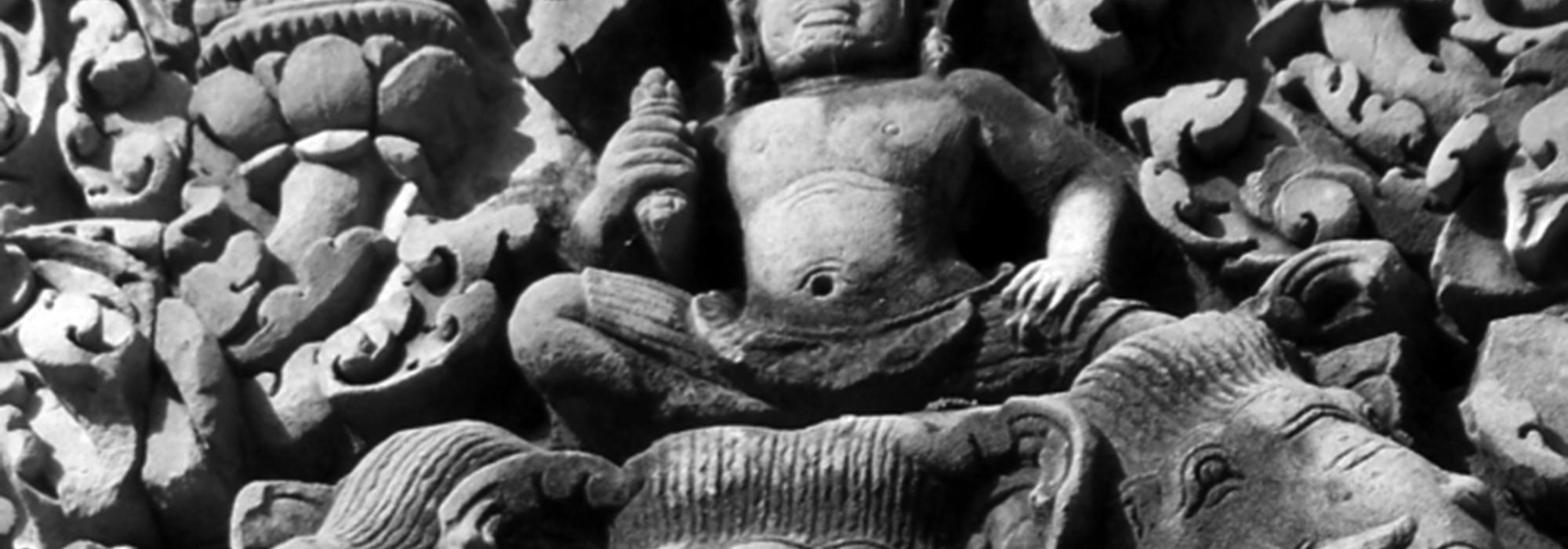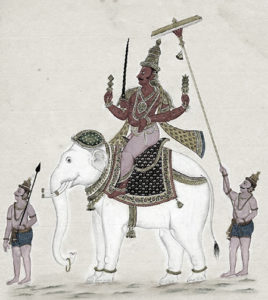Since how long has the spirit of strength and courage been in the world? Indeed for thousands of years. In the Upanishads – the preeminent portion of the Vedas – we have a famous story of the creation of braahma, kshaatra, vaishya, and shudra along with dharma (Brhadaranyaka Upanishad 1.4). All the varnas arose from Prajapati (Brahma).
While Indra is a symbol for kshaatra, Agni is a symbol for braahma. Many suktas from the Rigveda Samhita are in praise of Indra, who can be called as the primary deity of the Rigveda. The threads of that spirit of courage, be it Vishnu or Shiva, end up joining Indra. Even Skanda, who is married to Indra’s daughter Devasena, ends up there. Among the prominent deities in the Vedas – Indra, Vishnu, and Rudra specifically represent kshaatra. Varuna, in addition to kshaatra, maintains the universal order. In the Puranas we find detailed lineages of deities and seers. From Brahma came the nine Brahmas (or Prajapatis). Among them, in the line of Bhrgu seers, the children of Bhargava represent kshaatra and courage. Among the Angirasas, the braahma that drove the essence of kshaatra was prominent. Further, kshatriyas like Sindhudvipa, Vishvamitra, and Devapi became great seers. Thus we see the spirit of kshaatra even in sages. Similarly, in the background of the modern branch of study, anthropology, we first see the element of kshaatra; it arose the moment there was disorder in human society. The moment we want order, we need kshaatra. To think of it, for the language of human society, kshaatra is the grammar. Grammar needs an underlying vision (or philosophy). That is braahma. Just like a human language needs grammar, society needs kshaatra.
It is pointless asking why. We must say, “I drink water,” and not “I eat water.” Why can’t we say the latter? One shouldn’t, that’s it. Similarly, we must use ‘he’ when speaking about a man and ‘she’ when speaking about a woman, not the other way round. Of course, by saying something ungrammatical, reality will not change but surely our communication is affected. And in turn, our reality also gets affected. Why so? It’s a rule. It is not something that can be questioned. We have to agree upon certain fundamental principles. Order emerged when spatiotemporal principles emerged. Language is subservient to its time in history.
Similarly, we must accept the fact that kshaatra too is a product of nature; it manifests itself at all times. Anthropologists tell us that in the early days, the carnivorous predators were the earliest threat to humans and in order to fight them, the need for a man in the frontline arose. From here kshaatra was born. In fact, we see this in ourselves every day. How can we function if the element of kshaatra is not within us? The reflex action that is built within us for protection is a manifestation of kshaatra. The hormones secreted by our endocrine glands pump into our bodies the sense of awareness, enthusiasm, and caution. Doctors tell us that if these hormones are in excess, they cause great disturbance. Hence, temperance is important. It is basic knowledge that our white blood corpuscles keep us safe from diseases; they fight against bacteria and viruses, thus protecting the body by their sacrifice. Isn’t this a form of kshaatra-dharma? In nature, kshaatra is inevitable. There is no way we can question this. Culture grows in conformity with nature; so it must. If not, destruction will be guaranteed.
It was utterly unwise of Jawaharlal Nehru to say that India doesn’t need an army. Gandhi also had said something similar. After attaining independence, we were in a dilemma whether or not have an army – it was so foolish! On the other hand, greats like P S Shivaswamy Iyer, Venkatarama Shastry, and V S Srinivasa Shastry had deeply studied and spoken about how India’s army should be after independence and how the structure of the armed forces should be once there is transfer of power; we find this in the writings of D V Gundappa.
If any country has to establish itself, it has to be on the foundation of kshaatra fostered by braahma. If we had fought a bloody war with the British and gained our freedom, perhaps we would not have been so irresponsible. We did not win our freedom, we just happened to find it. It was thrown out somewhere and we got it by chance. And since we got it thus, we don’t know its value. When we obtained our freedom, we should have been prepared for a war. Keep aside the loss of life and land when Pakistan attacked Kashmir, a vast expanse of Indian land nearly 1,200 miles in length and 80,000 sq. miles in area is disputed territory with China. The borders with these two large countries – China and Pakistan – are unclear today; we don’t know where to draw the border. Documents suggest that 80,000 sq. miles of Indian land has been forcibly taken over by China. This apart, we don’t know how much more is gone. And the reason for this is a lack of kshaatra, nothing else.
The fact that it is impossible to reject something in nature can be seen through the lens of Ayurveda as well. In the Caraka Samhita, when speaking about the qualities of health, it first deals with what is required for the body. When explaining the concept of brahmacarya, our ancient writers of the dharmashastras have given the meaning to be – “there is brahmacarya even in the life of a householder when there is mutual love and affection between husband and wife.” The dharmashastras mention that sex within the framework of marriage is to be considered brahmacarya. Vagbhata, while detailing this in his Astangahrdaya, says that a value like brahmacarya is important for the body and mind of the people at large and that it is also good for health. Explaining the word ‘abrahmacarya,’ Cakrapani, Dalhana, and others, in their commentaries have equated it with ‘sex’ and ‘sexual intercourse with women.’ However, our ancient seers have agreed that the actions that are inevitable for the dharma of the body have to be embraced. While explaining ‘व्यवायः कामभोगः,’ we can see that our tradition of shastra writers has given it a concrete meaning. Further, if we obsessively cling on to illusory ideals, then not only will we be destroyed, we will be destroying the lives of many people who depend on us.
With this background, when we examine Nehru's statement that we don’t need an army, we realize its utter foolishness. The perils of ignoring nature arise from illusory ideals or from an obsession to criticize and destroy. In the Gita, Krishna tells Arjuna,
“Even if you say, ‘I will not fight’ out of ego, you can’t abide by your decision; प्रकृतिस्त्वां नियोक्ष्यति – you will be forced otherwise by your own nature.” (BG 18.59)
This is indeed true. When we see it from this perspective, we find that kshaatra is aligned to both nature and culture. Protection (and self-preservation) is innate in every living being, whether it is conscious of it or not. In that it is unique. The ancient writers of shastras have mentioned that the fundamental qualities of all beings are food, sleep, sex, and fear. The basic quality of a kshatriya is 'भयाद्रक्षणम्,' protecting one from fear and establishing safety. Thus we have to prove the existence of kshaatra while examining the basic building blocks of our world.
Translated from Kannada by Hari Ravikumar


















































